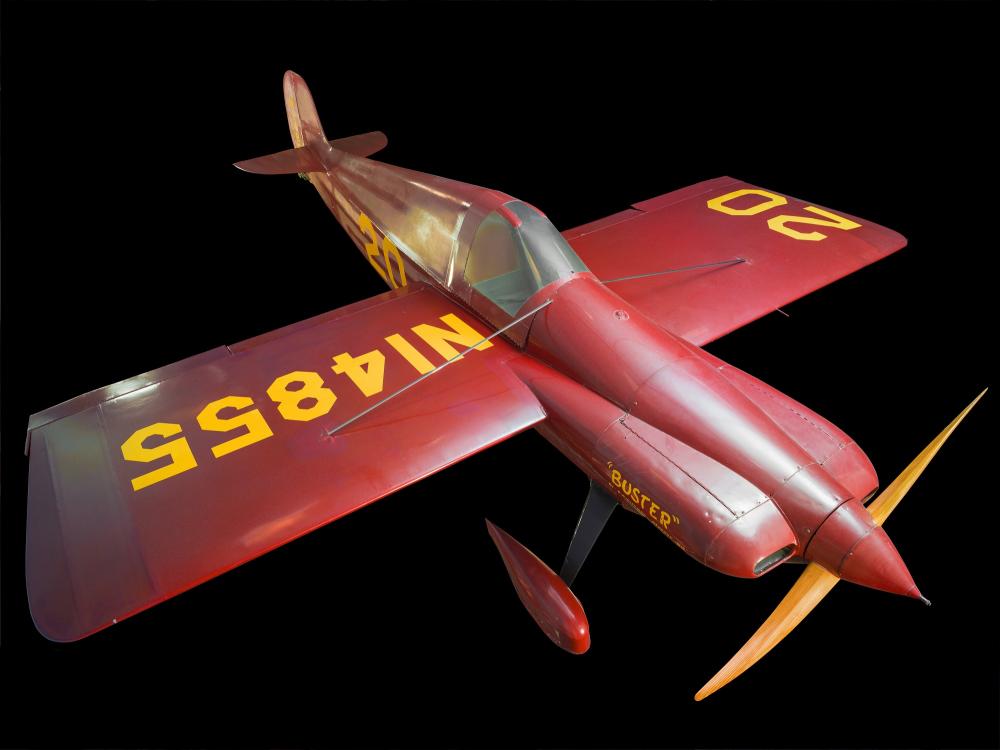
The Many Lives of Buster the Air Racer
Sep 06, 2019
By Jeremy Kinney

Sep 06, 2019
By Jeremy Kinney
Since the earliest days of flight, air racing has been an exciting motorsports activity. The National Air and Space Museum has in our collection many of the aircraft that made history by winning races and setting records. Jimmy Doolittle’s R3C-2, Roscoe Turner’s Meteor, Darryl Greenamyer’s Conquest I, the Mahoney family and Don Peck’s Sorceress, and Jon and Patricia Sharp’s Nemesis siblings, the DR 90 and NXT, stand out as achievements of design, skill, ingenuity, and speed. Another clear winner is Steve Wittman’s Special 20 Buster that was on display at the Museum on the National Mall for decades until the Golden Age of Flight exhibition recently closed as part of our multi-year renovation. Buster lived two lives in air racing and proved to be an inspiration for an entire class of air racers.
Buster was known as Chief Oshkosh from 1931 to 1938. Legendary air racer and aircraft home builder Steve Wittman designed the racer to compete at the National Air Races. He named the racer in honor of the Native American leader that gave the name to his new hometown, Oshkosh, Wisconsin. Wittman won and placed in multiple competitions over the course of those seven years while consistently modifying and improving the racer until a 1938 crash landing led to his storing the wrecked Chief Oshkosh.
In 1947, Wittman and his protégé Bill Brennand brought Chief Oshkosh out of storage and rebuilt it for competition in what was called “midget” air racing at the time due to the diminutive size of the racers. Goodyear Aviation and Continental Motors sponsored nationwide trophy contests for these aircraft that competitors built to specifications based on engine size, weight, and propeller and landing gear configuration, which was a predecessor to today's Formula One air racing. Wittman and Brennand modified Chief Oshkosh’s fuselage and installed a Continental C-85 engine and new wings. He renamed the racer Buster after a favorite comic strip character well known in American popular culture, the mischievous Buster Brown.
Buster went on to a second successful career in air racing from 1947 to 1954. Over those years, Wittman and his team continued to modify and improve the racer. Bill Brennand flew it to victory in the 1947 and 1949 Goodyear Trophy races held during the National Air Races in Cleveland, Ohio, and consistently placed in various events across the United States. Pilot Bob Porter took over racing duties in 1951 and flew Buster in its last race, a third-place finish in the Continental Motors Race at Dansville, New York, on July 4, 1954. Buster entered the Smithsonian collection in its 1954 configuration shortly after that.
Buster was installed in the Museum’s Golden Age of Flight exhibition in the 1980s in celebration of its two racing histories. When Golden Age of Flight closed in early 2019 as part of the Museum’s renovation project, Buster was lowered and transported to the Museum’s Steven F. Udvar-Hazy Center in Chantilly, Virginia. There, it received preservation treatment in the Mary Baker Engen Restoration Hangar. Buster will return to the National Mall as part of the Barron Hilton Pioneers of Flight exhibition in the early 2020s.
Characterized by its mid-wing, steel tube, wood, and fabric construction, Buster influenced highly successful Formula One air racers that followed. Steve Wittman built Little Bonzo, now in the collection of the Experimental Aircraft Association Museum in Oshkosh, from scratch in 1948 and flew it successfully for 40 years. Homebuilder Tom Cassutt looked to Buster for inspiration for his Cassutt Special in 1954, a cornerstone design that persists today in Formula One air racing in both its original and highly-modified forms. Buster’s legacy in air racing goes well beyond its wingspan of 15 feet and length of 17 feet.
Jeremy Kinney curates the Air Racing collection at the Museum.

We rely on the generous support of donors, sponsors, members, and other benefactors to share the history and impact of aviation and spaceflight, educate the public, and inspire future generations. With your help, we can continue to preserve and safeguard the world’s most comprehensive collection of artifacts representing the great achievements of flight and space exploration.
We rely on the generous support of donors, sponsors, members, and other benefactors to share the history and impact of aviation and spaceflight, educate the public, and inspire future generations. With your help, we can continue to preserve and safeguard the world’s most comprehensive collection of artifacts representing the great achievements of flight and space exploration.